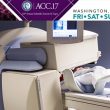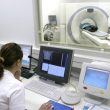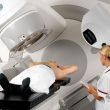This statement is based on eye exams conducted during the last SCAI meeting (Society for Cardiovascular Angiography and Interventions), where 47% of evaluated operators had radiation related lesions in their crystalline. In time, these might turn into cataract. Studies on astronauts and Chernobyl survivors have shown a clear association between ionizing radiation and crystalline damage,<a href="https://solaci.org/en/2017/05/30/nearly-half-of-interventional-cardiologists-may-have-pre-cataract-lesions/" title="Read more" >...</a>
Cardiovascular MR Perfusion Imaging: Good Initial Alternative in Stable Chronic Angina
In the initial management of patients with stable chronic angina, a non-invasive strategy with cardiovascular MR perfusion imaging seems to provide similar results to invasive strategies. At one year, MACE rate (combination of all cause death, non-fatal infarction and target vessel revascularization) resulted 3.3% for MRI vs. 3.9% for fractional flow reserve (FFR) informed<a href="https://solaci.org/en/2017/04/12/cardiovascular-mr-perfusion-imaging-good-initial-alternative-in-stable-chronic-angina/" title="Read more" >...</a>
New Technique to Calculate CT-Derived Fractional Flow Reserve: Is It Accurate?
This study describes the accuracy of the new computed tomography (CT) technique to calculate fractional flow reserve (FFR). Other CT techniques to measure FFR use allometric scaling and assume coronary microvascular resistance. However, instead of assuming these parameters, this new technique calculates them based on coronary and aorta lumen deformation. The accuracy of this<a href="https://solaci.org/en/2017/01/20/new-technique-to-calculate-ct-derived-fractional-flow-reserve-is-it-accurate/" title="Read more" >...</a>
Radiotherapy: Post PCI Cardiovascular Death Predictor
Original Title: Long-Term Mortality in Patients With Radiation-Associated Coronary Artery Disease Treated with Percutaneous Coronary Intervention. Reference: Reed GW et al. Circ Cardiovasc Interv. 2016 Jun;9(6). Courtesy of Dr. Brian Nazareth Donato. Radiotherapy is often used to treat malignant tumors; however, it is associated with adverse cardiovascular effects such as constrictive pericarditis, valve deterioration<a href="https://solaci.org/en/2016/07/04/radiotherapy-post-pci-cardiovascular-death-predictor/" title="Read more" >...</a>
Could CT angiography replace coronary angiography in the short term?
Original Title: CT Angiography for the Prediction of Hemodynamic Significance in Intermediate and Severe Lesions. Head-to-Head Comparison with Quantitative Coronary Angiography Using Fractional Flow Reserve as the Reference Standard. Reference: Matthew J. Budoff et al. J Am Coll Cardiol Img. 2016;9(5):559-564. The aim of this study was to compare the diagnostic accuracy of non-invasive<a href="https://solaci.org/en/2016/05/06/could-ct-angiography-replace-coronary-angiography-in-the-short-term/" title="Read more" >...</a>
Occupational Hazzard in the Cath Lab
Original Title: Occupational Health Risks in Cardiac Catheterization Laboratory Workers. Reference: Maria Grazia Andreassi et al. Circ Cardiovasc Interv. 2016 Apr;9(4). Orthopedic lesions and radiation exposure are among the health risks Cath Lab staff take. However, the potential occupational hazard in quantitative terms is still unclear. The purpose of this study was to examine the<a href="https://solaci.org/en/2016/04/26/occupational-hazzard-in-the-cath-lab/" title="Read more" >...</a>
SCAI Releases Expert Consensus for Cardio-Oncology Patients Treated in Cardiac Catherization Labs
The Society for Cardiovascular Angiography and Interventions (SCAI) has released an expert consensus statement providing cardiologists, oncologists and internal medicine physicians guidance for treating patients facing concomitant cardiovascular disease and cancer. The document, “SCAI Expert Consensus Statement: Evaluation, Management, and Special Considerations of Cardio-Oncology Patients in the Cardiac Catherization Laboratory,” was released in Catheterization and Cardiovascular Interventions (CCI),<a href="https://solaci.org/en/2016/01/19/scai-releases-expert-consensus-for-cardio-oncology-patients-treated-in-cardiac-catherization-labs/" title="Read more" >...</a>
PROMISE Subanalysis: Potential Benefits of CT Angiography over Functional Studies in Patients with Symptoms Suggesting CAD
Original Title: Outcomes of anatomical versus functional testing for coronary artery disease. Presenter: Douglas PS. Early this year, the PROMISE trial was not able to confirm that testing patients with chest painusingcomputed tomography angiography (CTA) instead of functional tests, affects clinical outcomes, even though several sub analysis are currently suggesting other additional benefits,including enhanced diagnostic<a href="https://solaci.org/en/2015/11/20/promise-subanalysis-potential-benefits-of-ct-angiography-over-functional-studies-in-patients-with-symptoms-suggesting-cad/" title="Read more" >...</a>
PROMISE: Functional Test versus tomography for diagnosis of coronary artery disease
This is the first randomized controlled trial to compare the effectiveness of a functional test versus angiography by tomography (≥64 cuts) to diagnose coronary artery disease. The study included 10003 patients from 193 centers who were symptomatic but no previous diagnosis of coronary artery disease. The study found no difference in prognosis between patients who<a href="https://solaci.org/en/2015/06/24/promise-functional-test-versus-tomography-for-diagnosis-of-coronary-artery-disease/" title="Read more" >...</a>
MOZART: IVUS reduces contrast volume needed for angioplasty
Contrast nephropathy is associated with increased morbidity and so this study evaluates the possibility of reducing the required necessary volume of contrast using coronary intravascular ultrasound (IVUS). Patients were randomized to IVUS guided angioplasty (n = 41) and angiography guided angioplasty (n = 42). IVUS-guided angioplasty requires a smaller volume of contrast (22.9 ± 12.5<a href="https://solaci.org/en/2015/06/24/mozart-ivus-reduces-contrast-volume-needed-for-angioplasty/" title="Read more" >...</a>








